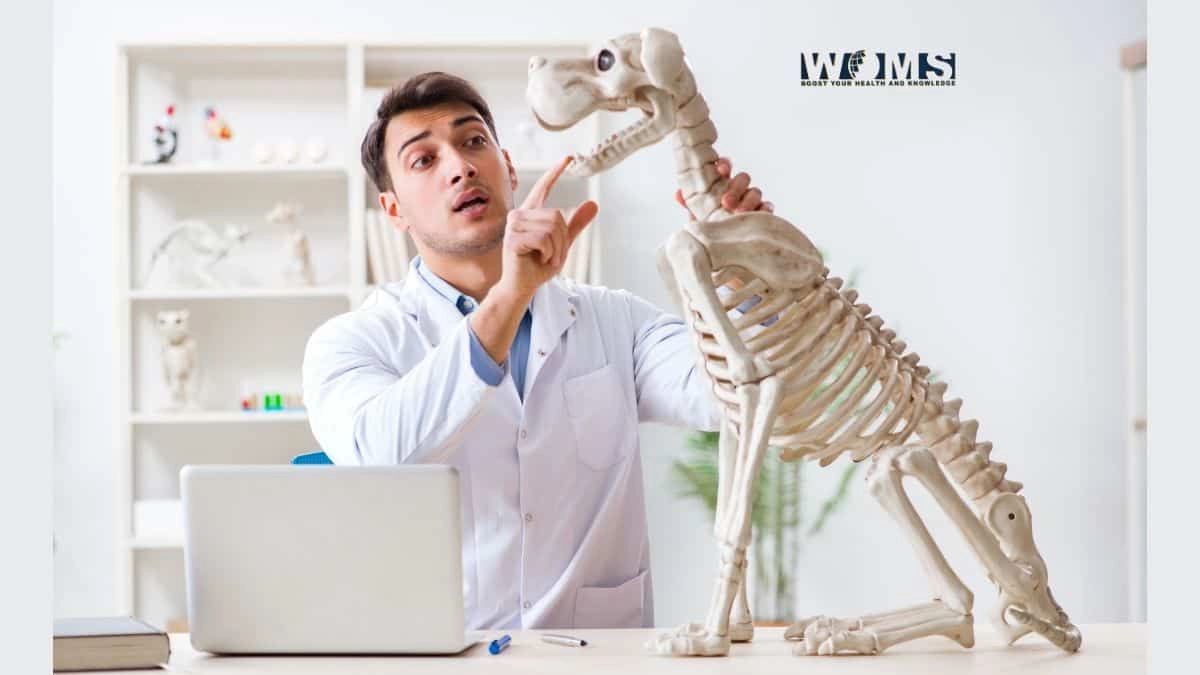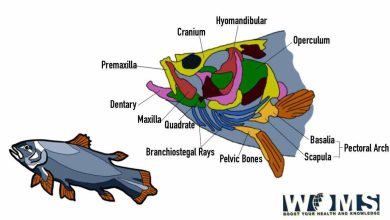Dog Skeleton: Anatomy and Vitals

A dog’s skeleton is a fascinating thing to study. It has many similarities to our anatomy and some differences worth mentioning. For example, dogs have fewer ribs than humans because they don’t need as much support to hold up their bodies. They also have an extra bone in the back of their skull that helps them rotate their heads around better than we can!
One of the most important things to know about a dog’s skeleton is where its vital organs are located. Let’s take a closer look at each one:
Heart: The heart is located in the middle of the chest, just behind the sternum.
Lungs: The lungs are located on either side of the heart and extend down to the ribcage.
Stomach: The stomach is located on the left side of the body, just below the ribs.
Kidneys: The kidneys are located near the lower back on either side of the spine.
Bladder: The bladder is located just in front of the pelvic bone.
As you can see, a dog’s anatomy is very similar to our own but also has some differences that are worth noting.
What type of skeleton do dogs have?
The canine skeleton is the most interesting of all pet skeletons. They have a very similar skeletal makeup to humans, but their stature is much different.
A dog has 206 bones in its body and shares 24 with humans. In addition, dogs only share two fewer ribs than people do, 28 for canines compared to 30 for us! Dogs also have more vertebrae (another name for backbones) at 42 while we only have 33!
Let’s take a look at the dog’s skeleton and learn more about it!
- Their skull is much different than ours.
- They have one less tooth in their mouths – 42 teeth compared to our 32!
- The biggest difference between dogs and humans (besides height) is that dogs only walk on their toes while we do both: walking with our heel first then toe last.
- Dogs also don’t share all of the same bones as us; they seem similar because most animals’ skeletal systems are built similarly. For example, canines lack collarbones which makes them unable to lift or carry things around easily, like people who use this bone often for carrying backpacks or purses around town.
What is the function of the skeletal system in dogs?
Bones provide rigid structure structural support and protect internal organs.
The skeletal system also helps regulate blood calcium levels, store minerals to maintain pH balance in the body fluids, release energy for cell metabolism through the hydrolysis of phosphate groups during bone resorption, produce red blood cells to carry oxygen throughout the body (hematopoiesis), provide points of attachment for muscles used in locomotion or muscular respiration, act as levers that cause movement by their attachments via joints on bones with movable parts such as those found within limbs, and are involved in endocrine regulation due to calcitonin secretion from C-cells which regulates serum calcium levels.
The skeletal system is divided into two categories
Axial and appendicular. The axial skeleton consists of the skull, vertebral column, and ribcage. The appendicular skeleton includes the limbs (upper and lower extremities) and the pectoral (chest) and pelvic girdles.
How are dog skeletons adapted?
- Dogs have skeletons disconnected shoulder bones that are very similar to human skeletons. Their spine, skull, and limbs have adapted for their body weight by being sturdier than the same bones in people would be. They also have a light rib cage to run quickly without tiring out too easily.
- A dog’s head is held up high, which allows them to see over tall grass or other obstacles while running at full speed through rough terrain after prey or escaping predators.
- The canine teeth are very sharp and pointy, which helps them grip their prey securely. These strong molars crush bones easily so the dogs can eat the entire carcass, including the skin and fur.
- The tail is also very important for balance and communication. The tail acts as a counterbalance when the dog turns quickly, so they don’t overstretch themselves or fall easily. It can be carried straight out behind them to let other dogs know that they are friendly, inviting playtime fun with no danger of attack from this direction, at least! Dog swag their tails in different ways depending on what mood they’re in, which helps us understand how our canine friends feel by watching body language more closely than we might otherwise have done if it were not for these signals being communicated through the movement of the tail!

Are all dog skeletons the same?
No! They have a large proportion of braincase in their skulls, more cervical vertebrae, which allows for better movement when compared to other mammals, and an adaptation for running with longer leg bones giving it power when they move at speed. All dogs are not the same due to these differences, especially in their skeletal structure, making them highly adapted for running very fast. Although the canine skeleton is similar in overall structure to other mammals, there are significant differences. For example, the dog’s skull has a larger proportion of braincase than that of other animals. Dogs also have more cervical vertebrae (seven) than other mammals (six), allowing for greater head and neck mobility.
The canine skeleton is also highly adapted for running. The bones of the legs are elongated, and the joints are very flexible, allowing dogs to cover great distances quickly.
Do dogs have flexible bones?
A dog’s skeleton consists of bones that are not as rigidly held together as human bones. This allows dogs to twist and turn their bodies to accomplish acrobatic feats that would otherwise be impossible for a person with stiffer joints.
Dog’s spine is more flexible than the spine of humans because it consists of individual vertebrae, each one separated by an intervertebral disc which acts as a shock absorber during movement. The shoulder blades of all four-legged animals allow them to rotate around their axes so they can reach under themselves easily without having to contort into unnatural positions. A dog has adapted its body structure over time so it could run faster through long distances while chasing prey or escaping from predators. They have also evolved sharp teeth used for tearing meat apart
What is the most common canine skeletal disorder?
Many congenital skeletal disorders affect dogs. The most common are hip Dysplasia, osteochondrosis dissecans (OCD), hypertrophic osteodystrophy, and panosteitis.
- Hip Dysplasia is the loosening of the joints between bones which results in pain for your dog and difficulty walking or standing up. This disorder typically affects larger breeds such as German Shepherds or Labradors but can appear in smaller breeds too. Medication, surgery, and weight management may help alleviate symptoms depending on the severity of the disease; in some cases, it will require euthanasia if not treated effectively early enough.
- Osteochondrosis Dissecans cause cartilage tissue to die due to lack of blood supply resulting in bone-on-bone contact. OC is a common joint disorder in larger breeds of dogs and can often be treated with surgery if caught early.
- Hypertrophic Osteodystrophy is a condition that affects puppies between the ages of four to eight months old. It is caused by an overgrowth of bone tissue, leading to pain, lameness, and fever. Th s disorder usually resolves itself within a few weeks or months, but some cases may require surgery.
- Panosteitis is inflammation of the long bones in young dogs, typically around six to eighteen months old. The cause is unknown, but it is thought to be a virus or genetics. Affected dogs will have sudden episodes of limping, refusing, and being very restless. The symptoms will usually go away within a few days but can return. There is no specific treatment for panosteitis, just time and rest.
If you are ever concerned about your dog’s health or think it may have a skeletal disorder, don’t hesitate to get in touch with your veterinarian. Early diagnosis and treatment are key to preventing more serious problems down the road. Your vet will help diagnose the disorder and recommend an appropriate treatment plan.
Are dogs’ skulls stronger than humans’?
While dogs have thicker skulls than humans, this is not necessarily an indicator that their skulls are stronger. The apocryphal story about boxer dogs’ molars and human wisdom teeth says more about the way we treat our pets than it does about any anatomical differences between humans and canines.
Dog skeletons share many of the same bones with humans and feature some very similar joint types. Dog skeletons have a few unique features like carnassial teeth, but those aren’t what give them such tremendous biting power.
What lets dogs crunch down on bones and tough prey is their jaw muscle mass. The muscle is significantly larger in dogs than in humans, giving them a considerable advantage when hunting and scavenging.
One thing that isn’t as strong in dogs as it is in some other animals is the dog’s spinal cord. Dog skeletons are susceptible to disc rupture, which can lead to paralysis.
When caring for a dog skeleton, it’s important to be aware of these key anatomical features and consider them when handling or displaying the remains.
- Dogs have thicker skulls than humans, but this does not necessarily mean they are stronger
- The apocryphal story about boxer dogs’ molars and human wisdom teeth is more about the way we treat our pets than it does about any anatomical differences between humans and canines
- Dog skeletons share many of the same bones with humans and feature some very similar joint types as well – Dogs do have a few unique features like carnassial teeth, but those aren’t what give them such tremendous biting power
- What lets dogs crunch down on bones and tough prey is their jaw muscle mass which is significantly larger in dogs than it is in humans
- One thing that isn’t as strong in dogs as it is in some other animals is the dog’s spinal cord which makes them susceptible to disc rupture
- When caring for a dog skeleton, it’s important to be aware of these key anatomical features and take them into account when handling or displaying the remains.
What is a dog’s armpit called?
The dog’s armpit is referred to as its axillary lymph nodes. These unique structures only occur in canines and are found where the front leg meets the body beneath the fur of their underarm (axilla). Their main function is defense by providing immunity against infections at early stages before they spread throughout other parts of the canine’s body. Suppose you notice that your furry friend has lumps or bumps around this area. In that case, it may indicate infection present within these important immune cells, so be sure to consult with a veterinarian immediately!
Are dogs’ necks stronger than humans’?
Unlike your neck, your dog’s neck is much more mobile. Your dog’s neck consists of seven bones, whereas yours has only four. The extra three are the hyoid bone or lingual sheath that supports your tongue. These additional bones allow for greater mobility in a dogs’ neck over ours because they rotate their head 270 degrees. The movement of the hyoid bone is also what allows your dog to make all those funny expressions with its head.
After looking at how different our necks are, you might think that dogs’ necks would be better suited for carrying heavy objects or supporting their weight like ours do when we need to stand on two feet. However, this isn’t true because it turns out that humans have a higher overall strength in their necks than dogs do, but only by about ten percent. The truth is that while humans’ muscles are much stronger overall, they can’t hold themselves up for as long compared to your average canine. While a petite human may tire after holding his or her body weight at arm’s length for half an hour, most dogs can do this for hours on end without breaking a sweat.
What this means is that while dogs may not be able to out-maneuver us in all areas, they are still much better suited for activities that involve holding their head up high or looking around.
One last interesting fact about dog necks is that the atlas and axis vertebrae (the first two cervical bones) are not fused as they are in humans. This allows dogs to twist their heads from side to side so that they can see everything happening around them – something which we cannot do.
So, now you know that when it comes to neck strength and flexibility, your average dog reigns supreme! Next time you’re out walking with your pup, be sure to take a moment to appreciate all the amazing things their neck can do.
What are dogs joints called?
- The stifle joint (often stifle) is the joint of the hind leg between the femur and tibia. It is also known as the knee. The name comes from the Latin stipes, meaning “stick.”
- The elbow (or carpus) is a simple hinge joint formed by the radius and ulna bones of the forearm. It allows rotation around a vertical axis, such as when you turn your hand over.
- The hock (metatarsus or pedestal) is the ankle joint in dogs and other animals. It consists of two condyles on either side of a prominent ridge, forming an angle slightly greater than 90 degrees between them. The distal phalanx rests on this prominence on either side when dogs are standing to support most of their weight.
- The shoulder (or scapula) is the joint between the dog’s upper arm bone (humerus) and the shoulder blade (scapula). It has a wide range of motion, allowing dogs to run, jump and paddle.
- The hip or coxofemoral joint is the most complex joint in the dog’s body. It is a ball-and-socket joint formed by the femur and pelvis. The socket is deep and oval-shaped, while the head of the femur is round like a ball. This gives it great flexibility for rotating and moving forwards and backward.
- The jaw (mandible) consists of two bones: the dentary, which houses teeth, and the angular, which articulates with the skull. The bones of this joint meet at a right angle and consist of hinge-like movements that allow for up and down movement, opening and closing the mouth to grasp food before swallowing it.
- The sternum (breastbone) is formed from three separate ossification centers in the manubrium, body, and xiphoid process; fusion occurs between the 18th and 20th week of fetal development.
- The vertebral column (or spine) comprises 33 bones, called vertebrae. These are divided into five regions: cervical (neck), thoracic (chest), lumbar (lower back), sacral (pelvic), and caudal (tail). The first seven vertebrae make up the dog’s neck, 12 the chest, and six forms the lower back. There are usually four fused sacral vertebrae, although some breeds may have as few as two or as many as six. The last three to five vertebrae make up the tail.
Each bone in the dog’s skeleton is unique has a specific name:
- Cranium
- Hyoid
- Scapula
- Humerus
- Radius and ulna
- Carpal bones (wrist) include the carpal bones that make up your dog’s “knee,” called the stifle joint. The carpals are also found in men, but they’re not referred to as a knee because it’s a hinge joint, rather than a ball and socket like a human has. In dogs, however, there is no difference between these two types of joints, so we have deemed them all knees…
Conclusion
As you can see, dog skeletons are similar to human ones. They have 206 bones and share many vital organs with us too!




